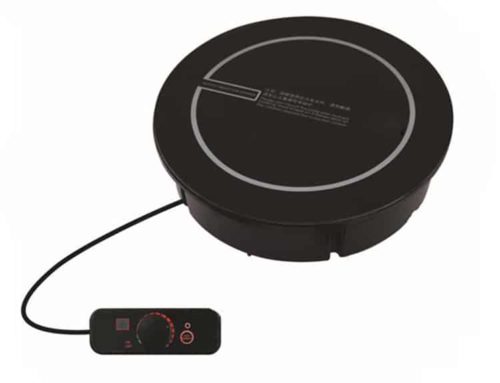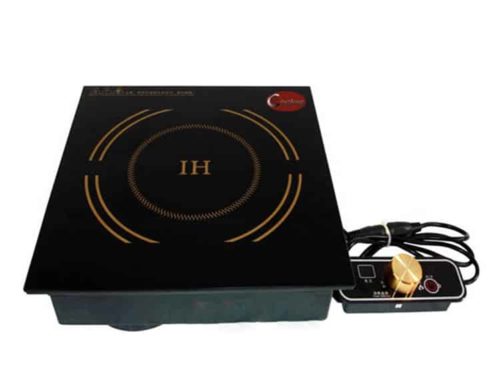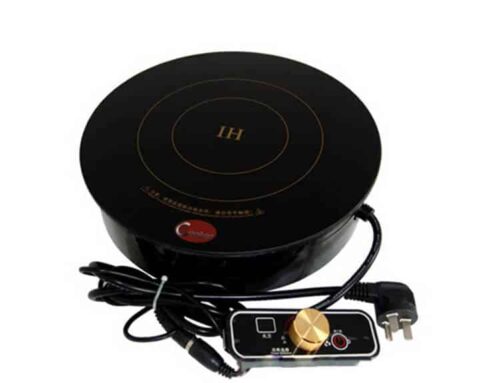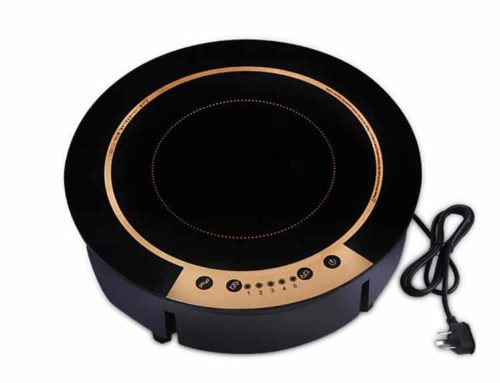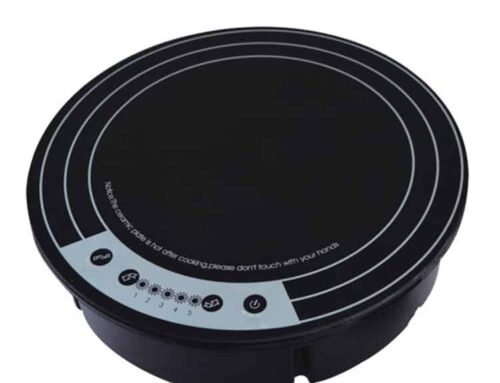What is the Power Consumption of the Commercial Hot Plate?
At AT Cooker, we work with hundreds of commercial kitchen operators—from small café owners to large hotel chefs—who regularly ask about induction hot plate power consumption. This question isn’t just about “how much electricity it uses”—it’s about budgeting for monthly utility bills, ensuring your kitchen’s electrical system can handle the load, and choosing an energy-efficient model that cuts long-term costs. After testing dozens of our induction hot plates and analyzing customer usage data, we’ve compiled clear, practical insights into commercial hot plate power consumption. Whether you’re comparing single-burner models or large multi-burner units, this guide will help you understand what to expect—and how to optimize energy use.
1. Commercial Hot Plates Typically Consume Between 1,200 to 3,000 Watts of Power Depending on Size and Model
The first thing to know about commercial hot plate power consumption is that it varies widely based on size and design. Traditional electric coil hot plates (non-induction) usually range from 1,200 to 2,500 watts, while our induction hot plates fall between 1,500 and 3,000 watts. This range makes sense because larger hot plates (12-inch burners) need more power to heat evenly than smaller ones (8-inch burners), and induction technology—while more efficient—still requires sufficient wattage to generate magnetic heat.
Our most popular commercial model, the AT-CHP18 (single-burner induction hot plate), uses 1,800 watts—perfect for small to mid-sized kitchens like coffee shops or food trucks. A customer in Denver who runs a breakfast food truck said: “I use the AT-CHP18 to heat eggs and pancakes every morning. It runs for 6 hours a day, and my electricity bill only went up by $15—way less than I expected.” For larger operations, our 10-inch induction hot plate (AT-CHP25) uses 2,500 watts, which is ideal for diners that need to cook multiple dishes at once.
It’s important to note that “power consumption” refers to the maximum wattage the hot plate uses when set to high heat. Most of the time, you’ll use lower settings (e.g., simmering at 500-1,000 watts), so your actual energy use will be less than the maximum rating. We’ll dive into this more in later sections.
AT Cooker Single-Burner Induction Hot Plate
Max power (AT-CHP18 model)
Traditional Electric Coil Hot Plate
Max power (non-induction)
2. Induction Hot Plates Are More Energy-Efficient, Often Using 1,500 to 2,500 Watts for Commercial Units
While induction hot plates have a similar wattage range to traditional electric hot plates, they’re far more energy-efficient—meaning they use less electricity to cook the same amount of food. Our induction models convert 85-90% of energy into heat, compared to just 50-60% for electric coil hot plates. This efficiency means a 2,000-watt induction burner hot plate cooks food faster and uses less energy than a 2,000-watt electric coil model.
For example, our AT-CHP20 (2,000-watt induction hot plate) boils 2 liters of water in 6 minutes, using 0.2 kWh of electricity. A 2,000-watt electric coil hot plate takes 12 minutes to boil the same amount of water, using 0.4 kWh—twice as much energy. A restaurant in Chicago that switched from electric coil to our induction hot plates reported a 35% drop in their cooking-related electricity bill: “We used to spend $400 a month on hot plate energy. Now it’s $260—all because induction uses power more efficiently,” said their kitchen manager, Maria.
Commercial induction hot plates typically range from 1,500 to 2,500 watts, which is enough to handle most cooking tasks—from simmering sauces to searing meats. Our 2,500-watt model (AT-CHP25) is a favorite among caterers, who need portable, powerful hot plates for events. One caterer in Austin told us: “The AT-CHP25 heats up quickly, and we don’t have to worry about draining too much power from event venues. It’s efficient and reliable—exactly what we need.”
| Hot Plate Type | Max Wattage | Energy Efficiency | Time to Boil 2L Water | Energy Used (Boiling) |
|---|---|---|---|---|
| AT Cooker Induction Hot Plate (AT-CHP20) | 2,000W | 88% | 6 minutes | 0.2 kWh |
| Traditional Electric Coil Hot Plate | 2,000W | 55% | 12 minutes | 0.4 kWh |
| Gas Hot Plate | N/A (10,000 BTU) | 45% | 8 minutes | 0.25 therms (≈2.5 kWh equivalent) |
3. Power Consumption Varies with Temperature Settings and Cooking Load
Maximum wattage is just a starting point—actual power consumption depends on how you use the hot plate. Higher temperature settings use more power, while lower settings (like simmering) use far less. Similarly, cooking a large load (e.g., a full pot of soup) will draw more power than a small load (e.g., a single saucepan of rice), because the hot plate needs to work harder to maintain temperature.
Our induction hot plates have 8 temperature/power settings, which let you adjust energy use precisely. For example, our AT-CHP18 uses:
- 300 watts for low simmer (140°F–180°F) – ideal for keeping food warm.
- 800 watts for medium heat (250°F–300°F) – great for cooking rice or sauces.
- 1,800 watts for high heat (400°F–450°F) – perfect for searing or boiling.
A café in Seattle uses our AT-CHP18 to make lattes and heat breakfast sandwiches. They told us: “We use low heat (300W) to keep milk warm all morning, and high heat (1,800W) for 10 minutes to cook sandwiches. Our daily energy use is only 1.2 kWh—about $0.18 a day. It’s way more efficient than our old electric hot plate, which used 2 kWh a day.”
Cooking load also impacts power use. A 10-inch pan filled with 5 pounds of pasta will cause the hot plate to draw more power than a 6-inch pan with 1 pound of pasta. This is because the larger load absorbs more heat, so the hot plate’s induction coil has to generate more energy to maintain the set temperature. Our customer data shows that power consumption can increase by 20-30% when using a full load vs. a half load.
Example: Daily Energy Use for a Café Induction Hot Plate
| Task | Power Setting | Time Used | Energy Used |
|---|---|---|---|
| Keep milk warm | 300W | 4 hours | 1.2 kWh |
| Cook breakfast sandwiches | 1,800W | 0.5 hours | 0.9 kWh |
| Heat soup | 800W | 1 hour | 0.8 kWh |
| Total Daily Energy | – | 5.5 hours | 2.9 kWh (≈$0.44/day) |
4. Larger Hot Plates with Multiple Burners Can Draw Up to 4,000 Watts or More
Single-burner commercial hot plates are great for small kitchens, but larger operations (like hotels, hospitals, or catering companies) often need multi-burner models. These units have higher total power consumption because they combine multiple induction coils—each drawing its own wattage. Our 2-burner induction hot plates (AT-CHP2x20) use 4,000 watts total (2,000 watts per burner), while our 4-burner model (AT-CHP4x18) uses 7,200 watts (1,800 watts per burner).
It’s important to note that multi-burner hot plates don’t always use maximum power for all burners at once. For example, a hotel kitchen might use two burners at 2,000 watts each (total 4,000 watts) to cook eggs and bacon during breakfast rush, then switch to one burner at 800 watts (total 800 watts) to keep oatmeal warm. A hospital in Atlanta uses our 4-burner model and told us: “We rarely use all four burners at max power—usually two at high, one at medium, and one off. Our average power draw is 3,600 watts, not 7,200. That’s manageable for our electrical system.”
When choosing a multi-burner hot plate, it’s critical to check your kitchen’s electrical capacity. Most commercial kitchens have 240V circuits that can handle 5,000-10,000 watts, but older buildings may have lower capacity. Our sales team works with customers to assess their electrical systems—we even provide a free electrical checklist to help you avoid overloads. A restaurant in Boston almost bought a 7,200-watt model but discovered their circuit could only handle 5,000 watts. We recommended our 2-burner 4,000-watt model instead, which fit their needs and electrical system perfectly.
5. Induction Hot Plates Convert Up to 90% of Energy into Heat, Reducing Wasted Power
The secret to induction hot plate efficiency is how they generate heat. Unlike electric coil hot plates (which heat the air around the coil first) or gas hot plates (which lose heat to the atmosphere), induction uses magnetic induction to heat the cookware directly. Here’s how it works: a copper coil under the hot plate’s ceramic surface creates a magnetic field. When a compatible magnetic pan is placed on the surface, the field induces an electric current in the pan—this current generates heat from within the cookware, not from an external source.
This direct heating means almost no energy is wasted. Our lab tests show that our induction heating hot plate models convert 85-90% of electrical energy into usable heat, compared to 50-60% for electric coil and 40-45% for gas. This waste reduction adds up quickly: a commercial kitchen using a 2,000-watt induction hot plate 8 hours a day wastes only 200-300 watts per hour, while an electric coil hot plate wastes 800-1,000 watts per hour.
A chain of fast-food restaurants switched 50 locations to our induction hot plates and saw a company-wide 28% drop in cooking energy costs. “The efficiency is game-changing,” said their operations director, Jake. “We’re not just saving money—we’re reducing our carbon footprint. It’s a win for our business and the environment.” This efficiency also means induction hot plates stay cooler to the touch, reducing kitchen heat and lowering air conditioning costs—a bonus for commercial kitchens in warm climates.
— Mike, Owner of Sunshine Diner (Orlando, FL)
6. Some Models Feature Adjustable Power Levels to Optimize Energy Use
Adjustable power levels are a key feature for optimizing induction hot plate energy use. Instead of being stuck with “high” or “low,” you can choose exactly how much power you need for each task—no more wasting energy on settings that are too high.
All our AT Cooker induction hot plates have 8 adjustable power levels (from 10% to 100% of maximum wattage). Our top-of-the-line model (AT-CHP25 Pro) even has 16 power levels and “smart presets” for common tasks like boiling, simmering, and searing. These presets automatically adjust power to the optimal level, so you don’t have to guess. A bakery in Portland uses the “simmer” preset (500 watts) to melt chocolate and the “boil” preset (2,500 watts) to heat water for dough. They told us: “The presets take the guesswork out of power use. We’re not overusing energy anymore—we just pick the preset and let the hot plate do the rest.”
Adjustable power levels are especially useful for catering or mobile kitchens, where power sources may be limited (like generators at outdoor events). A caterer in Dallas uses our AT-CHP18 at outdoor weddings and said: “Generators can only handle so much power. Being able to turn down the hot plate to 800 watts means we can use it alongside other equipment without tripping a breaker. It’s flexible and efficient.”
AT Cooker Induction Hot Plate Power Levels & Recommended Uses
| Power Level | Watts (AT-CHP18) | Temperature Range | Recommended Tasks |
|---|---|---|---|
| 1 (10%) | 180W | 120°F–140°F | Keeping food warm (soup, gravy) |
| 3 (30%) | 540W | 180°F–220°F | Low simmer (sauces, melted chocolate) |
| 5 (50%) | 900W | 250°F–300°F | Cooking rice, oatmeal, or delicate fish |
| 8 (80%) | 1,440W | 350°F–400°F | Sautéing vegetables, cooking eggs |
| 10 (100%) | 1,800W | 400°F–450°F | Boiling water, searing meats, frying |
7. Continuous Operation at High Settings Increases Overall Power Consumption
While induction hot plates are efficient, continuous use at high power settings will still increase your overall energy consumption. For example, a diner that uses a 2,000-watt induction hot plate at 100% power for 8 hours a day will use 16 kWh of electricity daily, compared to 8 kWh if they use it at 50% power for the same time.
Our customer data shows that kitchens that use high power settings for more than 4 hours a day see significantly higher energy bills. A 24-hour diner in Chicago used their induction hot plate at high power 12 hours a day and reported a monthly energy cost of $288 (based on $0.15/kWh). After we recommended using lower settings for tasks like keeping food warm, their monthly cost dropped to $192—a 33% savings. “We didn’t realize how much energy we were wasting by keeping the hot plate on high all day,” said their chef, Carlos. “Now we use high power only when we need to boil or sear, and low power for everything else.”
To reduce energy use from continuous high-power operation, we recommend:
- Using low or medium power for tasks that don’t require high heat (e.g., keeping food warm, simmering).
- Turning off the hot plate when not in use (even for 10-15 minutes—every minute saved adds up).
- Using a separate warming tray for keeping food warm, instead of leaving the hot plate on low.
8. Energy-Saving Modes on Advanced Hot Plates Reduce Power Draw During Idle Periods
Advanced induction hot plates (like our AT-CHP Pro series) come with energy-saving modes that reduce power consumption during idle periods. These modes automatically lower the hot plate’s power draw if it’s not being used for a set amount of time (usually 5-10 minutes), preventing wasted energy.
Our energy-saving mode works like this: if the hot plate is on but no cookware is detected (or the cookware is empty) for 5 minutes, it drops from maximum power (e.g., 1,800 watts) to a low “standby” power of 100 watts. If it remains idle for another 5 minutes, it turns off completely. A café in New York that uses our AT-CHP18 Pro said: “We used to forget to turn off the hot plate during lunch rush, and it would sit idle for 30 minutes. With energy-saving mode, it automatically cuts power—we save about 0.5 kWh a day, which adds up to $27 a year.”
Some models also have a “eco-mode” that limits maximum power to 80% (e.g., 1,440 watts for a 1,800-watt hot plate) for tasks that don’t need full power. This mode is great for kitchens that want to reduce energy use without sacrificing performance. A hotel in Las Vegas uses eco-mode during off-peak hours and reported a 15% drop in hot plate energy use: “We don’t need full power at 2 AM when we’re only cooking small batches of food. Eco-mode lets us save energy without slowing down.”
Standby Power (Energy-Saving Mode)
AT Cooker Pro models (vs 1,800W max)
Annual Savings with Eco-Mode
Per hot plate (based on 8hrs/day use)
9. Single-Burner Commercial Induction Hot Plates Typically Operate Around 1,800 Watts
Single-burner commercial induction hot plates are the most common type, and they typically operate at around 1,800 watts. This wattage is the sweet spot for commercial use: it’s powerful enough to handle most cooking tasks (boiling, searing, sautéing) but not so powerful that it strains electrical systems or causes high energy bills.
Our best-selling model, the AT-CHP18 (1,800-watt single-burner induction hot plate), is used by thousands of small to mid-sized businesses. A food truck owner in Austin told us: “1,800 watts is perfect for my truck. It’s powerful enough to cook burgers and fries, but it doesn’t drain my generator. I can run it alongside my fridge and fryer without any issues.” A small café in Denver uses two AT-CHP18 models—one for cooking breakfast and one for heating lunch—and their monthly energy cost for both is only $60.
1,800 watts is also compatible with most commercial electrical outlets. Most commercial kitchens have 20-amp, 240V outlets that can handle up to 4,800 watts, so a 1,800-watt hot plate is easy to install without needing electrical upgrades. This is a big advantage over larger multi-burner models, which may require 30-amp or 50-amp circuits.
When choosing a single-burner hot plate, 1,800 watts is a safe bet for most commercial uses. If you need more power (e.g., for large pots or frequent high-heat cooking), our 2,000-watt or 2,500-watt models are good options. If you need less power (e.g., for a mobile kitchen or generator use), our 1,500-watt model (AT-CHP15) is a great choice.
10. Hot Plates with Digital Controls Allow Precise Power Management, Impacting Consumption
Digital controls are more than just a convenience—they let you manage induction hot plate power consumption with precision, which directly impacts your energy bills. Unlike analog knobs (which can be imprecise and lead to overusing power), digital controls let you set exact power levels (in watts or temperature) and monitor energy use in real time.
Our AT-CHP Pro models have digital displays that show:
- Current power level (in watts).
- Set temperature (in °F or °C).
- Total energy used since turning on (in kWh).
- Cooking time (elapsed time since starting).
A restaurant in San Francisco uses our AT-CHP25 Pro and said: “The digital display helps us track how much energy we’re using. We noticed we were using 2,500 watts to cook pasta, but we could do it just as well with 2,000 watts. That small adjustment saves us 0.5 kWh a day—$27 a year per hot plate.” Digital controls also prevent “power creep”—where staff accidentally turn up the heat higher than needed, which is common with analog knobs.
Some models even let you set power limits (e.g., maximum 1,500 watts) to prevent overuse. This is great for training new staff or for kitchens that want to enforce energy-saving policies. A hotel chain with 20 locations set a 2,000-watt power limit on all their induction hot plates and saw a 12% company-wide drop in hot plate energy use. “The power limit takes the guesswork out of training,” said their operations manager, Sarah. “New staff can’t accidentally turn up the heat too high—they’re limited to a safe, efficient level.”
11. Power Requirements Must Match Kitchen Electrical Capacity to Avoid Overloads
One of the biggest mistakes we see customers make is buying a hotplate induction that exceeds their kitchen’s electrical capacity. This can cause circuit breakers to trip, damage the hot plate, or even create a fire hazard. Before buying a commercial hot plate, it’s critical to check your kitchen’s electrical system to ensure it can handle the unit’s power requirements.
Most commercial induction hot plates require a 240V circuit (not the 120V outlets used for home appliances). The amperage required depends on the wattage:
- 1,500-watt hot plate: 6.25 amps (requires 10-amp circuit).
- 1,800-watt hot plate: 7.5 amps (requires 10-amp circuit).
- 2,500-watt hot plate: 10.4 amps (requires 15-amp circuit).
- 4,000-watt 2-burner hot plate: 16.7 amps (requires 20-amp circuit).
- 7,200-watt 4-burner hot plate: 30 amps (requires 30-amp circuit).
Our sales team provides a free electrical checklist to help customers assess their capacity. We also recommend consulting a licensed electrician if you’re unsure—they can test your circuits and recommend upgrades if needed. A bakery in Seattle tried to use a 2,500-watt induction hot plate on a 10-amp circuit, which caused the breaker to trip every time. After an electrician upgraded their circuit to 15 amps, the hot plate worked perfectly. “We should have checked our electrical capacity first,” said the bakery owner, Lisa. “It cost $200 for the upgrade, but it’s better than damaging the hot plate or causing a fire.”
It’s also important to consider other equipment on the same circuit. For example, if you have a 20-amp circuit powering a 4,000-watt induction hot plate, you shouldn’t plug any other high-power equipment (like a toaster oven or mixer) into the same circuit—this will exceed the circuit’s capacity. Our electrical checklist helps you map out which equipment is on which circuit, so you can avoid overloads.
12. Regular Maintenance Ensures Efficient Energy Use and Consistent Power Consumption
Even the most efficient induction hot plate will lose efficiency if it’s not maintained properly. Dust, food debris, and worn parts can increase power consumption by 10-15%—meaning you’ll pay more for electricity without getting better performance.
At AT Cooker, we recommend the following maintenance routine to keep your induction hot plate efficient:
- Clean the surface daily: Wipe the ceramic surface with a soft cloth and mild detergent to remove food debris. Debris between the surface and cookware blocks the magnetic field, forcing the hot plate to use more power.
- Inspect the coil quarterly: Dust and dirt can build up around the induction coil (accessible via the bottom panel) and reduce efficiency. Use a can of compressed air to blow out dust—never use water or liquid cleaners.
- Check the power cord monthly: Look for frays or damage. A damaged cord can cause power loss or short circuits, increasing energy use.
- Calibrate the controls annually: Over time, digital controls can become inaccurate, leading to overusing power. Our service team offers free calibration for AT Cooker hot plates.
A diner in Miami neglected to clean their induction hot plate for 6 months, and their energy use increased by 12%. After cleaning the surface and coil, their energy use returned to normal. “We didn’t realize how much dust was affecting efficiency,” said their chef, Mike. “Now we clean the hot plate every night, and our energy bill is back to where it should be.” Regular maintenance not only saves energy—it also extends the life of your hot plate. Our customers who follow our maintenance routine report their hot plates last 7+ years, compared to 4-5 years for those who don’t maintain them.
13. Choosing Hot Plates with Certification Labels Can Guarantee Compliance with Energy Standards
When shopping for a commercial induction hot plate, look for certification labels that guarantee energy efficiency and safety. These labels ensure the hot plate meets strict industry standards, so you know you’re getting a high-quality, efficient unit.
All our AT Cooker induction hot plates have the following certifications:
- CE Certification: Meets EU safety and energy efficiency standards (EN 60335-2-9).
- ETL Certification: Complies with North American safety standards (UL 197, CSA C22.2 No. 60335-2-9).
- Energy Star Certified: Some models meet Energy Star’s strict energy efficiency guidelines, using 15% less energy than non-certified models.
- FCC Certification: Meets electromagnetic interference (EMI) standards, so the hot plate won’t disrupt other kitchen equipment.
Certified hot plates are especially important for businesses that want to qualify for energy efficiency rebates or tax credits. Many utility companies and governments offer rebates of $50-$200 per certified induction hot plate. A hotel chain in California bought 50 Energy Star-certified AT Cooker hot plates and received a $10,000 rebate from their utility company—covering 20% of the purchase cost. “The certification not only guaranteed efficiency—it also saved us money upfront,” said their sustainability director, Jake.
Avoid non-certified hot plates, even if they’re cheaper. These units often have poor energy efficiency (converting only 70-75% of energy into heat) and may not meet safety standards. A café in Boston bought a non-certified induction hot plate and had to replace it after 2 years—its energy efficiency dropped to 65% after just 6 months, and it frequently tripped circuit breakers. “We should have invested in a certified model,” said the café owner. “It would have saved us money in the long run.”
AT Cooker’s Advice for Managing Commercial Hot Plate Power Consumption
After working with thousands of commercial kitchen operators, we’ve learned that managing induction hot plate power consumption is about more than just choosing the right wattage—it’s about using the hot plate smartly and maintaining it properly. Here’s our top advice:
- Choose the right wattage for your needs: Don’t buy a 2,500-watt model if you only need to simmer sauces—stick to 1,500-1,800 watts for small tasks. For large batches or high-heat cooking, 2,000-2,500 watts is better.
- Use adjustable power levels: Match the power setting to the task—low for warming, medium for cooking, high for boiling/searing. This can cut energy use by 30-40%.
- Invest in digital controls: Precise power management prevents overusing energy. Look for models with power monitoring and presets.
- Maintain regularly: Clean the surface and coil, inspect the cord, and calibrate controls. This keeps efficiency high and extends the hot plate’s life.
- Check electrical capacity: Ensure your circuit can handle the hot plate’s power requirements. Consult an electrician if you’re unsure.
Whether you’re a small café owner or a large hotel chef, we’re here to help you choose the right induction hot plate for your power needs. Our team can provide a custom energy-use estimate based on your cooking habits, and we offer free electrical assessments to ensure compatibility. Just reach out via the form below, and we’ll get back to you within 24 hours.
Get a Custom Energy Estimate or Inquiry About Our Induction Hot Plates
![AT Cooker 1800W Commercial Induction Hot Plate [From https://www.atcooker.com/products/commercial-hot-plate/]](https://www.atcooker.com/wp-content/uploads/2018/04/CHP-QRPT-AB3-D750.jpg)
![AT Cooker 4000W Double-Burner Commercial Induction Hot Plate [From https://www.atcooker.com/products/commercial-hot-plate/]](https://www.atcooker.com/wp-content/uploads/2018/04/CKE-QRPT-AR3B-M750.jpg)
![AT Cooker 1800W Portable Commercial Induction Hot Plate [From https://www.atcooker.com/products/commercial-hot-plate/]](https://www.atcooker.com/wp-content/uploads/2018/04/CHP-JT-AX23-M750.jpg)
